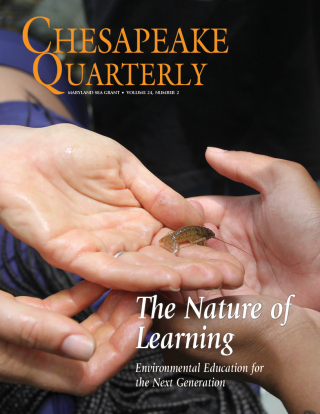Knauss legislative fellowships in Congress help build careers — and they're fun and educational. See our video and fact sheet for details.
R/SV-6
Causes of Benthic Cyanobacteria Overgrowth in Submersed Aquatic Vegetation (SAV) Beds in Chesapeake Bay: Potential Consequences for Ecosystem Resilience
Principal Investigator:
Judith O'NeilStart/End Year:
2022 - 2024Institution:
Horn Point Laboratory, University of Maryland Center for Environmental ScienceCo-Principal Investigator:
Jeffrey Cornwell, HPL, UMCES; Cassie Gurbisz, St. Mary's College of Maryland; Catherine Wazniak, MDDNR; J. Brooke Landry, MDDNRTopic(s):
- Research Projects
Strategic focus area:
Healthy coastal ecosystemsDescription:
Management efforts to reduce nutrient pollution have prompted the recovery of submersed aquatic vegetation (SAV) in the Chesapeake Bay (CB), particularly in the Bay’s tidal fresh and oligohaline waters. Unfortunately, benthic filamentous cyanobacteria have also become increasingly common in some of the areas where SAV is expanding the most. Although the prevalence of cyanobacteria is increasing globally, it is relatively uninvestigated in CB where it may threaten the stability and resilience of recovering SAV, disrupt the nutrient balance of SAV beds, which are generally thought to be nutrient sinks, and potentially affect recreational and commercial activities if they produce toxic compounds. The proposed research broadly aims to better understand the causes and effects of increasing benthic cyanobacteria abundance in CB. Our objectives are to 1) determine what conditions support cyanobacteria growth by conducting field surveys of cyanobacteria distribution in relation to SAV biomass and environmental variables in the upper CB and several oligohaline tidal tributaries 2) determine the effects of environmental variables (nutrients, light) on cyanobacteria production, nutrient uptake, nitrogen fixation, and potential toxin production by conducting bio-assay experiments, 3) assess the effects of cyanobacteria on biogeochemical rate processes and SAV via nutrient flux experiments and ecological simulation modeling exercises, and 4) determine whether toxins are present in cyanobacteria tissue and the water column through chemical analysis. We anticipate that our results will generate important scientific insights about the role of benthic cyanobacteria in shallow, oligohaline ecosystem recovery dynamics. These insights will also inform management efforts aimed at protecting human and ecological health in CB.
Impact/Outcome:
Several novel findings for the project:
- Sediment trapping by cyanobacterial filaments is very important in their nutrient ecology, particularly in relation to floating mats.
- The presence of saxitoxin in the Microseira (Lyngbya) wollei samples were higher in the beginning of the season (June) as opposed to later in the season (July). One hypothesis is that they may be devoting significant energy to herbivore defense by producing toxin early in the season, when the SAV is not as dense and the cyanobacteria is more exposed. Whereas later in the season, there is more protection from the dense SAV coverage, and during this time the cyanobacteria had higher growth rates.
- Microseira (Lyngbya) wollei fixes nitrogen at higher rates at the beginning of the season and then appears to switch to use of regenerated nitrogen, as determined by bioassay experiments; nitrogen fixation is also stimulated by additions of phosphorus in bioassays.
- There is a diverse population of cyanobacteria and microbes in the benthic mats growing on the SAV beds, many of which also have nitrogen fixing capacity.
- Cyanobacteria can effect sediment nutrient and oxygen fluxes: including high respiration, despite photosynthetic mass; denitrification is high and interestingly methane production detected likely from sediment particles entrapped in floating cyanobacterial filaments.
Project Accomplishments
Preliminary research investigating cyanobacteria on the Susquehanna Flats led to the first detected presence of a toxin linked to paralytic shellfish poisoning in other regions, in cyanobacterial mats on the bottom of the Susquehanna Flats seagrass beds, leading to genetic discovery of the toxin-producing cyanobacteria species.
Read more
Relevance The Susquehanna Flats is a large bed of submerged aquatic vegetation near the mouth of the Susquehanna River where it flows into the Chesapeake Bay. The cyanobacterium confirmed as Microseira (Lyngbya) wollei grows on the sediments of the Flats and can form stringy, matted tangles that float to the surface, blocking light from reaching the submerged aquatic grasses and potentially impacting their growth and sediment nutrient dynamics. These cyanobacteria became prominent in the Susquehanna Flats around 2010. Lyngbya can produce an array of toxins including those linked to dermatitis and paralytic shellfish poisoning (saxitoxin).
Response: Maryland Sea Grant-funded researchers identified the primary strains of cyanobacteria in the Flats as Microseria (Lyngbya) wollei through genetic sequencing. As part of the sampling, the researchers also documented the first observation of saxitoxins in Chesapeake Bay cyanobacterial mats, a potential source for paralytic shellfish poisoning.
Results: While no instances of paralytic shellfish poisoning have been reported in the Chesapeake Bay, the preliminary research findings raise further questions and highlight the importance of monitoring benthic algal mats and saxitoxins in the Bay. The team presented their results at research symposiums and public outreach events, held a data synthesis meeting with all project collaborators, and are preparing some manuscripts and additional field work.



